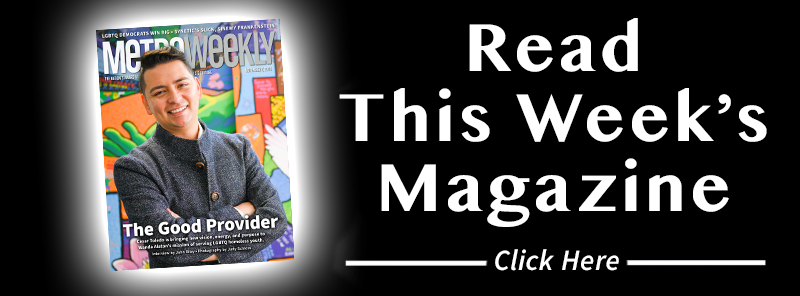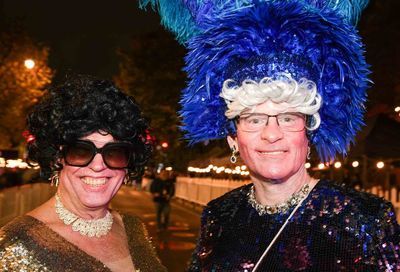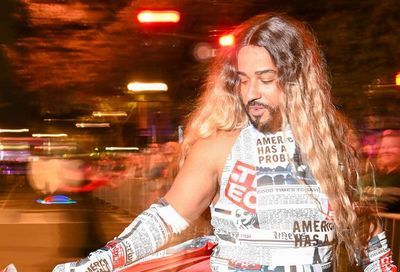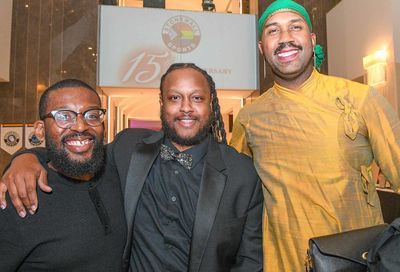Passing the Torch
The next generation gears up for Youth Pride
| Important Weather Notice: The Youth Pride Day Festival has been rescheduled to Saturday, June 4. Other events will continue as previously scheduled. Please visit the official YPD Website for full details. |
Since 1997, the Youth Pride Alliance has been bringing Youth Pride Day to D.C. It’s one of the few institutions aimed solely at the upcoming generation of LGBT people — or LGBTQI, to include those who are still questioning their orientation (“Q”) and those who are intersex (“I”), born with ambiguous genitalia. For the most part, these are youths that are cut out of the gay bar scene by virtue of being younger than 21. And while the bars may not be the center of gay universe they once were, they’re still pretty close.
That underage handicap combines with another handicap, which is regularly stoked by fear-mongers on the right. Their homophobia leads them to either equate gay people with pedophiles, or make absurd claims about gay people needing to “recruit” the next generation of gay Americans. Either way, their goal is to drive a wedge between generations of LGBT people.
Consequently, there is a limbo land populated by kids who have come out in some sense, but have not yet found a complete community to welcome them. Instead, they have Youth Pride, each other, and the few adults who have dedicated themselves to working with queer youth.
   Click for pics from Youth Pride 2004 Click for pics from Youth Pride 2004 |
Those aforementioned adults have also added the Sexual Minority Youth Assistance League to the mix. In a quiet, residential corner of Capitol Hill, just a block off Pennsylvania Avenue, sit the two adjoining row houses the constitute SMYAL’s physical presence. While the buildings themselves are fairly unassuming, the security protocols are not. SMYAL challenges the notion of gay adults exploiting kids. Accordingly, the organization seems to take its responsibility for the kids’ safety very, very seriously. If you’re in the 21-and-over set, don’t expect to drop by SMYAL unannounced and have a look around.
On a sunny, Friday afternoon, SMYAL is indeed a safe space. A couple dozen young people socialize or shoot hoops in the backyard. It’s a “drop-in” afternoon, and the kids seem happy.
“Here I feel as if I can be myself with no one looking at me awkwardly,” says Michael, 17. “That’s a big thing for me. At home, it’s not too good. It’s not too comfortable. This is the only place I’ve been so far that caters to GBTLQ youth. I don’t know what I’d do without the place. When I come here, it’s like a safe zone. The staff have been really comforting.”
Michael, like many of the clients at SMYAL that day, has been to Youth Pride in the past, and plans to attend this year’s version as well.
“Last year was my first year. It was really great,” he says. “It was just like the best thing in the world. It was like a whole day of being myself without worrying about someone having some smart comment. It was like total freedom, to do as you please, to be your complete self without having the slightest bit of worry about anyone having anything at all to say that would be negative. Pretty much everyone’s just like you.”
Eric Baker, a 20-year-old who identifies as questioning, will also be marking his second Youth Pride. He has similar sentiments. “I don’t know about everybody else, but I know myself and I’m going to have a good time,” he says. “I’m easy to get along with. I speak to everyone.”
Shelton Monk, 18, says of last year’s Youth Pride, “I felt wanted, I felt equal.” His friend Raypheal de’Barrows, 17, a relative newcomer from Houston, is a little apprehensive about attending Youth Pride, his first pride event of any kind.
“I’m just getting used to being around a lot of gay people,” de’Barrows explains. “Before I came [to SMYAL], I’d never been around this many gay people at one time. I’ve never been in a gay community, or something that’s just for gay people. I’m really a newcomer when it comes to being in the life…. Also, I’m from Houston. I’m a Southern boy. Coming to D.C. has also been a big change. I’m more accustomed to the Southern straight side of things, even though I’ve always known I was gay.”
There is, of course, more to being a young sexual minority in Washington than meeting your friends at SMYAL and going to Youth Pride. Gay peoples’ collective position in the American landscape always moves forward, sometimes by leaps and sometimes at a crawl. But even in these politically conservative times, change occurs. As the saying goes, however, the more things change, the more they stay the same.
For example, de’Barrows’s apprehension about Youth Pride pales next to his high-school-related anxieties. He recalls a teacher at his D.C. high school refusing to allow him to change his seat in class to distance himself from a bothersome student.
“Then I heard [the teacher] say under his breath, ‘fag,'” says de’Barrows. “I didn’t go to my class for the rest of the year because of that…. I couldn’t put myself back in that atmosphere. I felt bad that I let somebody — not just a student, but a teacher — stop me from getting my education. I don’t feel comfortable at school at all. Not so much because of the peers, but because of a lot of my teachers.”
Being gay got Monk kicked out of his home. “My mom basically put me out,” says the seemingly self-reliant Monk. “She says she accepts me being gay, but it’s like wishy-washy. One minute she’s okay with it, the next minute she’s verbally assaulting me. The majority of it is religion. She wants me back home, but I’m not all for that. I like being independent.”
Michael has an advantage over some of his peers at SMYAL, in that he says his parents have not abandoned him. His father has offered his love unconditionally, and his mother’s primary concern about her son being gay is that he’ll be harassed. It’s a well-founded fear, considering that Michael’s demeanor is fairly feminine and he says he’s often confused for a girl. He’s even considering attending college as a female. Until then, he’s attending a junior ROTC public charter school.
“We have to wear our uniforms on Thursday,” he explains. “When I’m at school, I’m male, because I don’t want to overdo anything. But I’m out. Everyone’s comfortable. There has been some disrespect from the males, mostly verbal. I’ve had one physical altercation out of my three years here…. I have one or two teachers who are supportive. I’m pretty much left alone. It works for me.”
Charlie Bright, 18, is the only one at SMYAL that day who says that he attends a high school with a Gay-Straight Alliance. That was in Arlington. Despite a possible lack of support at school, none of these kids placed any of the blame on the older LGBT generation for not coming to their rescue. Quite the contrary.
“I think they’re doing a very good job. The United States is not really for gays,” says Monk, explaining that the older generation of LGBT Americans has political constraints on how much it can do for the next generation.
“[The older LGBT generation] does try to support youth,” Bright insists. “I honestly think they’re doing what they can.”
Carlton Collins, 19, is the most insistent of the group, saying more Gay-Straight Alliances are needed — particularly in his former school, which he calls “very, very hostile.” He also offers the most praise for the job the older generation, gay and straight alike. “I love the mayor. And I love Phil Pannell. He came to my church. He’s very compassionate toward youth in the gay community.” Pannell is a local gay activist, and a founder of the D.C. Coalition, a D.C. organization for LGBT African Americans.
“I’m grateful that God has given us courageous and talented people to help LGBTQI youth succeed,” says Collins.
Aside from Collins, Bright also illustrates that the next LGBT generation is taking politics to heart.
“I pray someday I’ll see Rick Santorum walking down the street so I can kick him in the nuts,” Bright jokes, undeterred by the possibility of drawing the attention of the Capitol Police. Sen. Santorum (R-N.J.) has likened homosexuality to bestiality and pedophilia.
Adds Michael, “My biggest issue is feeling as if we’re going back into a prejudice period. But instead of black on white, it’s straight on gay. The election is a big part of it, but it’s more than that. It’s become so demeaning to be something that society says it’s wrong to be.”
Though these gay youths seem completely aware of the political pendulums current swing to the right, they maintain a youthful optimism about the future.
“Younger generations learn from the generation before,” says Baker, reckoning the only way is up for gay America. “Times change, and the younger generation keeps getting better and better and better every year.”
Bright imagines that in the future, major gay civil rights organizations like the Human Rights Campaign and the National Gay and Lesbian Task Force will be equal in stature to more established human rights groups, attracting more straight people to join their ranks. “I think there will be more involvement from all sorts of people,” he says. “These [LGBT] organizations will be like the [National Association for the Advancement of Colored People] — the pinnacle of human rights that everyone will work for.
Zack Thompson, 18, concludes: “If gay and lesbian people stand up for themselves, I think more people will stand up with us.”
If these kids from SMYAL are representative of American LGBT youth as a whole, Thompson shouldn’t have any worries about the next generation standing up. They seem ready to walk the road others have paved before them, and to make their own improvements.
Support Metro Weekly’s Journalism
These are challenging times for news organizations. And yet it’s crucial we stay active and provide vital resources and information to both our local readers and the world. So won’t you please take a moment and consider supporting Metro Weekly with a membership? For as little as $5 a month, you can help ensure Metro Weekly magazine and MetroWeekly.com remain free, viable resources as we provide the best, most diverse, culturally-resonant LGBTQ coverage in both the D.C. region and around the world. Memberships come with exclusive perks and discounts, your own personal digital delivery of each week’s magazine (and an archive), access to our Member's Lounge when it launches this fall, and exclusive members-only items like Metro Weekly Membership Mugs and Tote Bags! Check out all our membership levels here and please join us today!


























